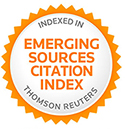Priorización de microcuencas en los Andes ecuatorianos usando parámetros morfométricos, WSA y GIS.
Resumen
El propósito es desarrollar un esquema de priorización y análisis de la fragilidad a factores geomorfológicos que viabilizan la erosión en cuatro microcuencas (MC), en una región montañosa y escarpada de la cordillera de los Andes ecuatorianos. Se cuantificaron los aspectos lineales de área y de relieve de cada una de las áreas de afectación de la red hidrográfica de las MC. Se encontró un modelo que permitió estimar los valores del Índice de Prioridad que demanda cada MC. Los resultados muestran que la microcuenca Pulpito (MCP) y la microcuenca Jubal (MCJ) son altamente susceptibles a erosión. Los factores de riesgo en la MCP, la MCJ y en la microcuenca Zula (MCZ) están más relacionados con procesos geomórficos fluviales. Mientras que en la microcuenca de Ozogoche (MCO), los factores de riesgo se encuentran relacionados con procesos geomórficos asociados a movimientos de masas.
Palabras clave
Texto completo:
PDFReferencias
AHER, P. D.; ADINARAYANA, J. & S. D. GORANTIWAR. 2013. «Prioritization
of watersheds using multi-criteria evaluation through fuzzy ana lytical
hierarchy process». Agricultural Engineering International: CIGR
Journal, 15(1): 11-18.
AHER, P. D.; ADINARAYANA, J. & S. D. GORANTIWAR. 2014. «Quantification
of morphometric characterization and prioritization for management
planning in semi-arid tropics of India: A remote sensing and GIS
approach». Journal of Hydrology, 511, 850-860. http://doi.org/10.1016/j.
jhydrol.2014.02.028
ALCÁNTARA-AYALA, I. & A. S. GOUDIE. 2010. Geomorphological Hazards and
Disaster Prevention. Cambrige University Press. Cambridge, UK.
BLACK, P. E. 2005. Watershed hydrology. John Wiley & Sons, INC. New York, USA.
GOBIERNO AUTÓNOMO DESCENTRALIZADO PARROQUIA RURAL DE ACHUPALLA.
Plan de desarrollo y ordenamiento territorial 2015-2019.
Alausí, Chimborazo, Ecuador.
HADLEY, R. F. & S. A. SCHUMM. 1961. «Sediment sources and dr ainage basin
characteristics in upper Cheyenne River basin». En: Water Supply. pp.
-196. U.S. Geological Survey, Paper 1531-B. Washington, USA.
HALL, M. L.; SAMANIEGO, P.; LE PENNEC, J. L. & J. B. JOHNSON. 2008.
«Ecuadorian Andes volcanism: A review of Late Pliocene to prese nt
activity». Journal of Volcanology and Geothermal Research, 176, 1-6.
http://doi.org/10.1016/j.jvolgeores.2008.06.012
HORTON, R. E. 1932. «Dranaige-basin characteristics». Eos, Transations
American Geophysical Union, 13(1), 350–361.
HORTON, R. E. 1945. «Erosional development of streams and their dr ainage
basins: hidrophysical approach to quantitative morphology». Geological
Society of America Bulletin, 56, 275–370. http://doi.org/10.1130/0016-
(1945)56
INFOPLAN. 2011. Información para el desarrollo - Oficina de planificación
de la Presidencia ODEPLAN. Quito, Ecuador.
KORNER, C. & M. OHSAWA. 2005. «Mountain Systems». En: Ecosystems and
Human Well-being: Current State and Trends. pp. 681-716. Islam Press.
Washington, D.C
KULKARNI, M. D. 2015. «The Basic Concept to Study Morphometric Analysis
of River Drainage Basin: A Review». International Journal of Science and
Research, 4(7), 2.277-2.280.
LAMA, T. D.; SINGH, R. K.; SAIKIA, U. S. & K. K. SATAPATHY. 2015. «Geomorphometric
analysis of a hilly watershed in north east India». International
Journal of Agriculture, Environment and Biotechnology, 8(1), 29-36.
http://doi.org/10.5958/2230-732X.2015.00004.2
MALIK, M. I. & M. S. BHAT. 2014. «Integrated Approach for Prioritizing Watersheds
for Management: A Study of Lidder Catchment of Kashmir
Himalayas». Environmental Management, 54, 1.267-1.287. http://doi.
org/10.1007/s00267-014-0361-4
MILLER, V. C. 1953. A quantitative geomorphic study of drainage basin
characteristics in the clinch mountain area Virginia and Tennessee.
Columbia University (No. CU-TR-3). New York, USA.
MINISTERIO DEL AMBIENTE DEL ECUADOR. 2012. Sistema de Clasificación
de los Ecosistemas del Ecuador Continental. (Eds. R. GALEAS y J. E.
GUEVARA). Subsecretaría de Patrinmonio Natural. Quito, Ecuador.
MISHRA, A. K. & K. S. RAWAT. 2015. «A Composite Watershed Prioritization
Index ( CWPI ) Based on Terrain Characteristics , Morphometry and
Soil Brightness Index ( SBI ) Using RS and GIS in Moolbari Watershed ,
Himachal Pradesh, India». International Journal of Remote Sensing and
GIS, 4(2), 87-101.
NAG, S. K. 1998. «Morphometric Analysis Using Remote Sensing Techniques
in the Chaka Sub-basin, Purulia District, West Bengal». Journal of
the Indian Society of Remote Sensing, 26(1 & 2), 69-76.
PARVEEN, R. 2012. «Geomorphometric Characterization of Upper South
Koel Basin, Jharkhand: A Remote Sensing & GIS Approach». Journal
of Water Resource and Protection, 04(12), 1.042-1.050. http://doi.
org/10.4236/jwarp.2012.412120
PATEL, D. P. & P. K. SRIVASTAVA. 2015. «Decision Support System integrated
with Geographic Information System to target restoration actions in
watersheds of arid environment: A case study of Hathmati waters hed,
Sabarkantha District, Gujarat». Journal of Earth System Science, 124
(1), 71-86.
RAHAMAN, S. A.; AJEEZ, S. A.; ARUCHAMY, S. & R. JEGANKUMAR. 2015.
«Prioritization of Sub Watershed Based on Morphometric Characteristics
Using Fuzzy Analytical Hierarchy Process and Geographical Information
System – A Study of Kallar Watershed, Tamil Nadu». Aquatic
Procedia, 4, 1.322-1.330. http://doi.org/10.1016/j.aqpro.2015.02.172
RATNAM, K. N.; SRIVASTAVA, Y. K.; VENKATESWARA RAO, V.; AMMINEDU,
E. K. S. R. & MURTHY. 2005. «Check dam positioning by prioritization
micro-watersheds using SYI model and morphometric analysis -
remote sensing and GIS perspective». Journal of the Indian Society of
Remote Sensing, 33 (1), 25-38. http://doi.org/10.1007/BF02989988
SCHUMM, S. A. 1956. «Evolution of drainage systems and slopes in badlands
at Perth Amboy, New Jersey». Geological Society of America
Bulletin, 67(5), 597-646.
SREEDEVI, P. D.; OWAIS, S.; KHAN, H. H. & S. AHMED. 2009. «Morphome -
tric analysis of a watershed of south India using SR TM data and GIS».
Journal Geological Society of India, 73, 543-552. http://doi.org/10.1007/
s12594-009-0038-4
SRINIVASA VITTALA, S.; GOVINDAIAH, S. & H. HONNE GOWDA. 2004.
«Morphometric analysis of sub-watersheds in the Pavagada rea of
Tumkur District, South India using remote sensing and GIS techniques
». Journal of the Indian Society of Remote Sensing, 32(4), 351-362.
http://doi.org/10.1007/BF03030860
STERN, C. R. 2004. «Active Andean volcanism: its geologic and tectonic setting
». Revista Geológica de Chile, 31(2): 161-206. http://doi.org/10.4067/
S0716-02082004000200001
STRAHLER, A. N. 1957. «Quantitative analysis of watershed geomor phology
». Transactions American Geophysical Union, 38(6), 913-920. http://
doi.org/10.1130/0016-7606
STRAHLER, A. N. 1964. «Quantitative Geomorfology of Drainage Basins
and Channel Networks». En: T. V. CHOW (Ed.), Handbook of Applied
Hydrology. pp. 39-76. McGraw-Hill. New York.
UNIVERSIDAD NACIONAL DE CHIMBORAZO (UNACH). 2011. Isoyetas en la
Provincia del Chimborazo. Riobamba, Ecuador.
UNITED NATION - INTERNATIONAL STRATEGY FOR DISASTER REDUCTION
(UN-ISDR). 2004. Terminology of disaster risk reduction. Geneva, Switzerland.
Disponible en: http://www.unisdr.org/eng/library/lib-terminologyeng{%}
VAN WESTEN, C. J. 2013. «Remote Sensing and GIS for Natur al Hazards Assessment
and Disaster Risk Management». En: J. SHRODER & M. P. BISHOP
(Eds.), Treatise on Geomorphology. pp. 259-298. Academic Press.
San Diego, California, USA. http://doi.org/http://dx.doi.org/10.1016/
B978-0-12-374739-6.00051-8
WINCKFLL, P. A. 1982. «Relieve y geomorfología del Ecuador». En: Geomorfología.
pp. 3-19. Centro Ecuatoriano de Investigaciones Geográficas.
Quito, Ecuador.
Enlaces refback
- No hay ningún enlace refback.
DOI: https://doi.org/10.53766/RGV
La Revista Geográfica Venezolana se encuentra actualmente indizada en:
 |  |  | |
 |  |  |  |
 |  |  |  |
![]()
Todos los documentos publicados en esta revista se distribuyen bajo una
Licencia Creative Commons Atribución -No Comercial- Compartir Igual 4.0 Internacional.
Por lo que el envío, procesamiento y publicación de artículos en la revista es totalmente gratuito.
